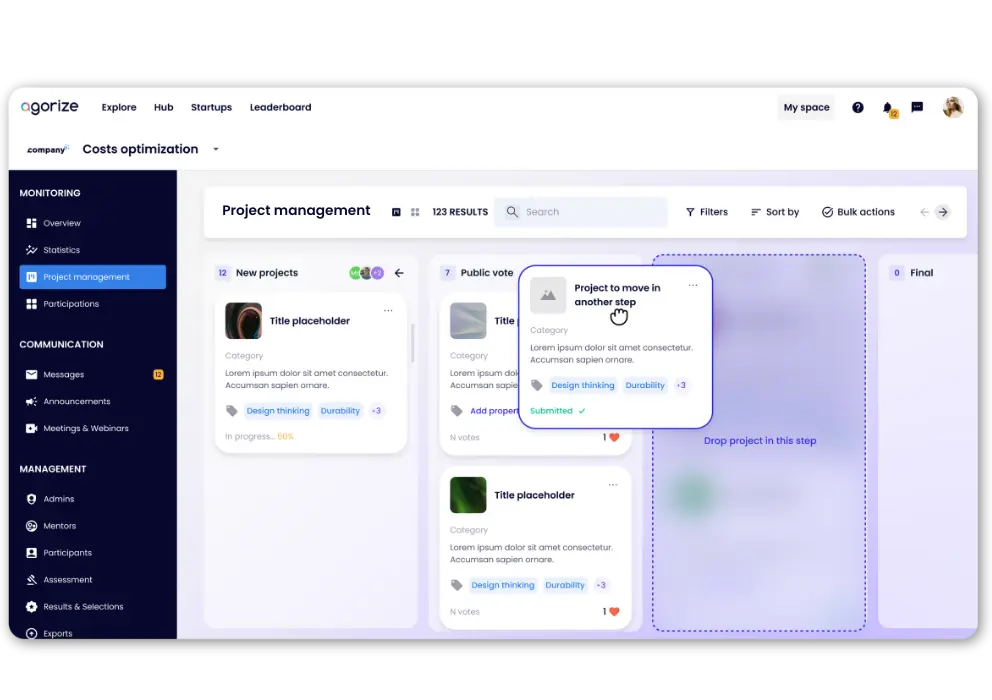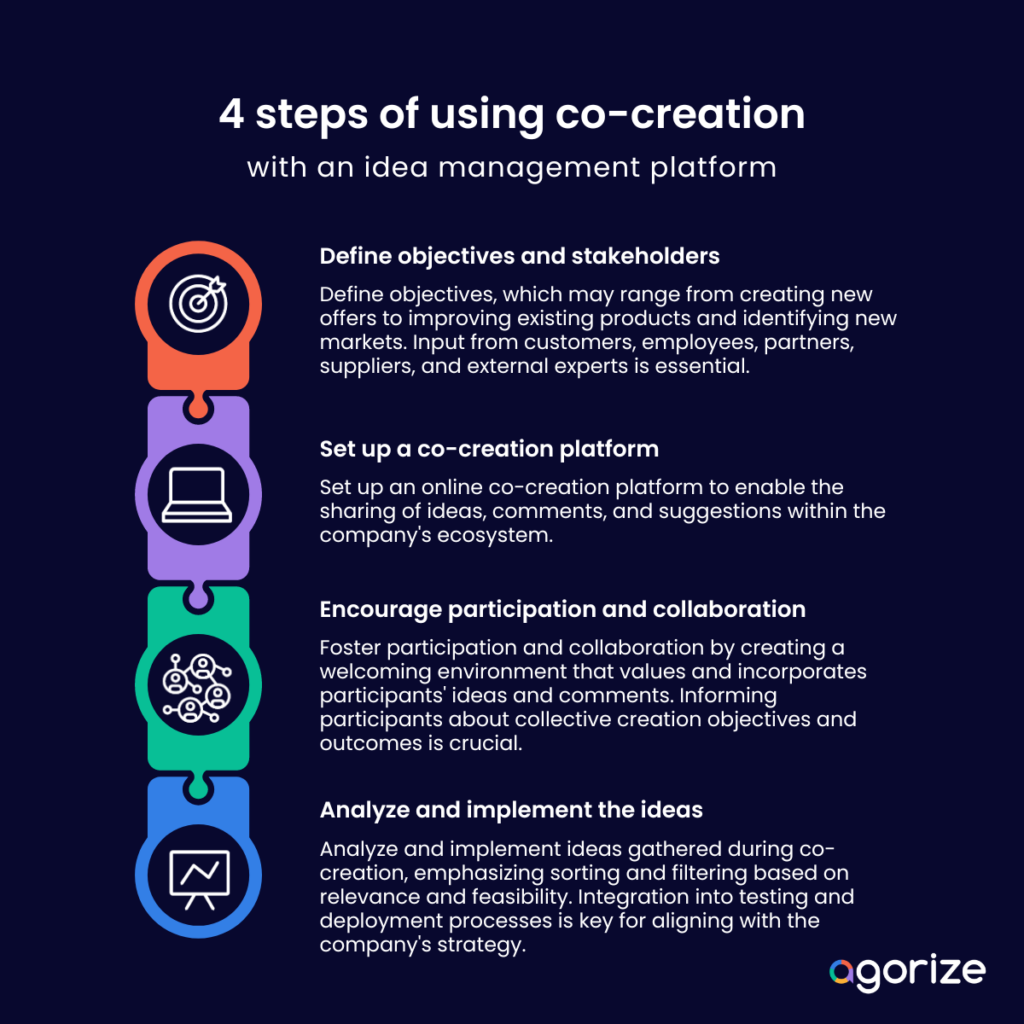Faced with changing markets, more and more companies are resorting to the concept of co-creation to meet customer expectations. The approach allows them to anticipate trends in a constantly evolving market, as we saw in our article on the importance of setting up a continuous improvement process. More than ever, innovation is a key factor in the transformation of companies to remain competitive.
Co-creation (or collective creation) is similar to the principle of continuous improvement in a few regards. First of all, it is a collaborative process that calls upon the collective intelligence of its ecosystem. It involves all players inside and outside the company to develop new ideas and solutions.
Read on to discover how you can start leveraging the value of co-creation in 4 simple steps. We also discuss how co-creation stimulates organizations’ innovation capabilities, helping you to gain a competitive advantage and improve the customers’ experience. Finally, we share some of our best practices to help you in the process.
What is co-creation?
Co-creation is a collaborative approach involving the stakeholders of a company in the development process of products, services, or processes. It is based on the joint effort of companies, suppliers, partners, and external experts. Together, they share their visions, new ideas, skills, knowledge, and resources.
The objective is to:
- Develop or improve products and services,
- Solve complex problems,
- Meet or anticipate market needs.
Co-creation was often associated with market research and focus groups, making the business and its customers work together as part of the marketing strategy development. Yet, co-creation goes far beyond participation marketing.
This co-creation process originates from companies’ awareness that customers are not passive beings, but active actors in the market. They can provide valuable information about their needs, expectations, and preferences. Additionally, companies have realized that their external partners bring complementary skills and knowledge, which help stimulate innovation by combining two sometimes fragmented complementary visions.
Co-creation efforts are therefore considered a value-creating process for organizations that put customers at the center of their new service or product development strategy.
Read also: What is idea crowdsourcing
What are the benefits of co-creation?
Based on this understanding of co-creation and collaborative innovation, several advantages for companies seeking to innovate and differentiate themselves in the market are identified.
Stay competitive
First of all, co-creation allows for the mobilization of skills, knowledge, and ideas held by actors in the company. People from different parts of the ecosystem complement each other with unique perspectives about the needs expressed by the market, the trends, and the innovation opportunities. Employees can also contribute their experience and expertise. Especially those who face customers and hear about feedback needs and wants daily.
In the name of the Common Higher Principle (Luc Boltanski), organizations that work together, better understand market expectations and adapt their strategy more effectively to remain competitive in the market.
Accelerate time to market
Another benefit of co-creation is the ability to accelerate the time to market for new products and services. External stakeholders can contribute their experience in the product development and commercialization phase. Through this, companies can save time and reduce the costs associated with new product development. This can be especially beneficial for companies looking to enter new markets or develop new offers in a tight timeframe.
As product users are already at the center of the innovation process from the start, time spent developing assumptions is reduced. Collaboration between the organization and its ecosystem allows it to have fast access and thorough knowledge of market expectations. Time spent on research and development is therefore reduced, as are the related costs and risks.
Improve a product or service
By involving their ecosystem, organizations can also improve the quality of their existing products and increase customer satisfaction. With the insight of its customers, employees, and ecosystem, they can identify the weaknesses of its products and work to improve them. Thanks to them, the company ensures that its offers meet the needs of the market.
Identify innovative ideas
Finally, using collective intelligence encourages the emergence of new and original ideas that add to the value chain, in collaboration with its internal and external ecosystem. Companies identify and develop innovative products or services that stand out from the competition. These ideas can also help strengthen the organization’s reputation for innovation and drive long-term growth.
As you can see, implementing co-creation projects offers many benefits to companies seeking to innovate and differentiate themselves in the marketplace. By mobilizing the skills, knowledge, and ideas of their ecosystem, organizations can identify new customer needs and market expectations. As a result, they can accelerate the time-to-market of new offers, or improve the quality of existing products to continuously ensure a positive customer experience and strengthen their brand image.
Beyond the impact on customers, this model also allows the company to enhance the value of its employees and partners by giving them a voice, once equipped with a centralized exchange platform. “Equipping yourself with such software is a good practice to adopt to keep employees engaged and reinforce their loyalty to the organization, it proves to be a space of expression reflecting the power of action of each contributor” – according to Alexandre Barthel, Marketing Director @ Agorize
Read also: The need for understanding employee engagement
The 4 steps of using co-creation with an idea management platform
To make co-creation a success in your organization, we’ve defined four steps to take based on the challenges many of our customers face today. Whether you’re leading a marketing team and want to position a new product or service, you aim to improve a supply chain process, or you want to radically change the design of products and services with the product team, co-creating value can be found in any team, with the right solution.
Define objectives and stakeholders
The first step in setting up a process to co-create is to clearly define the objectives and the stakeholders involved in the process. Objectives can vary depending on the needs of the company, such as creating new offers, improving existing products, identifying new markets, etc. They can require input from customers, employees, partners, suppliers, and external experts. Once identified, it is important to determine the best methods to involve them in your collective creation project.
Set up a co-creation platform
The second step is to set up an online co-creation platform that will allow your ecosystem to share their ideas, comments, and suggestions. An idea management platform like Agorize allows companies to call upon their internal and external communities. They can share their ideas on the platform and their peers can vote or come and amend these ideas. The company can then organize the different ideas collected in its ideation funnel and reveal the most promising ones to launch on the market. Organizing such programs will allow organizers to solve problems, improve products and processes, and acquire new expertise and perspectives.

Encourage participation and collaboration
The third step is to stimulate participation and collaboration. It is therefore important to provide a welcoming and respectful environment for participants, where their ideas and comments will truly be taken into account. Participants must be informed of the objectives of the collective creation process and the expected outcomes. Again, an idea management system can be a great tool for participants to collaborate and communicate effectively with the company. In addition, some platforms, such as the one developed by Agorize, are equipped with functionalities that make the user experience fun and therefore promote engagement. It simplifies the process of developing new ideas and solutions for the organizer as well as the participant.
Analyze and implement the ideas
This last step consists of analyzing the ideas, comments, and suggestions gathered during the co-creation process and implementing them. It is important to sort and filter the ideas according to their relevance and feasibility. Then, integrate them into the testing and deployment process contributing to the company’s strategy. To do this, idea management software can be used to grade and rank ideas for a better overview. Stakeholders are informed about how their ideas have been used and the results that are obtained consequently, thanks to a participant notification system.

Best practices for co-creating
When setting up an efficient collective creation process, it is important to follow certain best practices. First of all, it is essential to involve your ecosystem from the beginning. This includes customers, partners, and employees, including managers. This ensures a diversity of ideas and perspectives. Second, it is important to create an environment of trust and openness where community members can freely share their ideas without fear of criticism or rejection. They’d like to see sincere interaction from organizers, as it validates the value of their opinion. Companies should be transparent about how ideas are evaluated and implemented to encourage ongoing participation.
In addition, it is important to use idea management tools to track, evaluate, and organize the ideas collected. It is important to ensure that audiences engage on the platform through collaboration features and a gamified user experience, for example.
The implementation of such an approach must be accompanied by the development of an innovation culture within the company, in which experimentation and risk-taking are encouraged. Trying to solve complex challenges will require ongoing engagement which can only be maintained by an intrinsic motivation of employees.
Finally, employee training and awareness are key elements to ensure the success of the process. Employees must be trained to understand the benefits of co-creation, how to use idea management tools, and how to collaborate effectively with external communities.
By following these best practices, companies can drive innovation by harnessing collective intelligence, while strengthening their commitment to their customers and creating long-term value for all involved parties.
Read also: Aerospace innovations: Create the future of aerospace
Conclusion
Co-creation has many advantages for companies, allowing them to mobilize the skills and knowledge of their ecosystem to innovate and improve their product or service offerings. Implementing such an approach helps companies to identify new customer needs, accelerate the development of new offers, and improve the quality of their existing products. Without co-creation or open innovation, there is a risk of missing out on the information that can accelerate continuous growth.
However, for co-creation to be effective, it is important to consider some best practices. That is, to set up an adapted process, mobilizing the right audience according to the company’s objectives and the projects in progress. An idea management platform is a valuable tool to facilitate the co-creation process by allowing stakeholders to propose ideas and collaborate online, in the same way that CRM structures and helps the company’s sales approach.
Processes of co-creation stimulate innovation and competitiveness of companies while allowing them to better meet the needs of their customers and their ecosystem. By adopting a co-creation approach and mobilizing the skills and knowledge of community members, companies will be better equipped to meet tomorrow’s challenges and adapt to a constantly changing environment.
Co-creation is a collaborative approach involving the stakeholders of a company in the development process of products, services, or processes. It is based on the joint effort of companies, suppliers, partners, and external experts. Together, they share their visions, new ideas, skills, knowledge, and resources.
– Stay competitive
– Accelerate time-to-market
– Improve a product or service
– Identify innovative ideas










